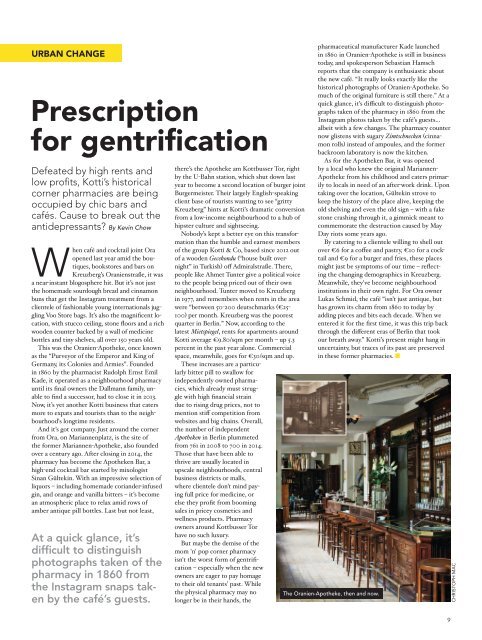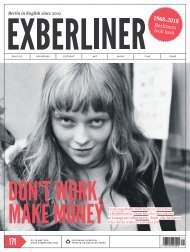EXBERLINER Issue 148 April 2016
Create successful ePaper yourself
Turn your PDF publications into a flip-book with our unique Google optimized e-Paper software.
URBAN CHANGE<br />
Prescription<br />
for gentrification<br />
Defeated by high rents and<br />
low profits, Kotti’s historical<br />
corner pharmacies are being<br />
occupied by chic bars and<br />
cafés. Cause to break out the<br />
antidepressants? By Kevin Chow<br />
When café and cocktail joint Ora<br />
opened last year amid the boutiques,<br />
bookstores and bars on<br />
Kreuzberg’s Oranienstraße, it was<br />
a near-instant blogosphere hit. But it’s not just<br />
the homemade sourdough bread and cinnamon<br />
buns that get the Instagram treatment from a<br />
clientele of fashionable young internationals juggling<br />
Voo Store bags. It’s also the magnificent location,<br />
with stucco ceiling, stone floors and a rich<br />
wooden counter backed by a wall of medicine<br />
bottles and tiny shelves, all over 150 years old.<br />
This was the Oranien-Apotheke, once known<br />
as the “Purveyor of the Emperor and King of<br />
Germany, its Colonies and Armies”. Founded<br />
in 1860 by the pharmacist Rudolph Ernst Emil<br />
Kade, it operated as a neighbourhood pharmacy<br />
until its final owners the Dallmann family, unable<br />
to find a successor, had to close it in 2013.<br />
Now, it’s yet another Kotti business that caters<br />
more to expats and tourists than to the neighbourhood's<br />
longtime residents.<br />
And it’s got company. Just around the corner<br />
from Ora, on Mariannenplatz, is the site of<br />
the former Mariannen-Apotheke, also founded<br />
over a century ago. After closing in 2014, the<br />
pharmacy has become the Apotheken Bar, a<br />
high-end cocktail bar started by mixologist<br />
Sinan Gültekin. With an impressive selection of<br />
liquors – including homemade coriander-infused<br />
gin, and orange and vanilla bitters – it’s become<br />
an atmospheric place to relax amid rows of<br />
amber antique pill bottles. Last but not least,<br />
At a quick glance, it’s<br />
difficult to distinguish<br />
photographs taken of the<br />
pharmacy in 1860 from<br />
the Instagram snaps taken<br />
by the café’s guests.<br />
there’s the Apotheke am Kottbusser Tor, right<br />
by the U-Bahn station, which shut down last<br />
year to become a second location of burger joint<br />
Burgermeister. Their largely English-speaking<br />
client base of tourists wanting to see “gritty<br />
Kreuzberg” hints at Kotti’s dramatic conversion<br />
from a low-income neighbourhood to a hub of<br />
hipster culture and sightseeing.<br />
Nobody’s kept a better eye on this transformation<br />
than the humble and earnest members<br />
of the group Kotti & Co, based since 2012 out<br />
of a wooden Gecekondu (“house built overnight”<br />
in Turkish) off Admiralstraße. There,<br />
people like Ahmet Tunter give a political voice<br />
to the people being priced out of their own<br />
neighbourhood. Tunter moved to Kreuzberg<br />
in 1977, and remembers when rents in the area<br />
were “between 50-200 deutschmarks (€25-<br />
100) per month. Kreuzberg was the poorest<br />
quarter in Berlin.” Now, according to the<br />
latest Mietspiegel, rents for apartments around<br />
Kotti average €9.80/sqm per month – up 5.3<br />
percent in the past year alone. Commercial<br />
space, meanwhile, goes for €30/sqm and up.<br />
These increases are a particularly<br />
bitter pill to swallow for<br />
independently owned pharmacies,<br />
which already must struggle<br />
with high financial strain<br />
due to rising drug prices, not to<br />
mention stiff competition from<br />
websites and big chains. Overall,<br />
the number of independent<br />
Apotheken in Berlin plummeted<br />
from 761 in 2008 to 700 in 2014.<br />
Those that have been able to<br />
thrive are usually located in<br />
upscale neighbourhoods, central<br />
business districts or malls,<br />
where clientele don’t mind paying<br />
full price for medicine, or<br />
else they profit from booming<br />
sales in pricey cosmetics and<br />
wellness products. Pharmacy<br />
owners around Kottbusser Tor<br />
have no such luxury.<br />
But maybe the demise of the<br />
mom 'n' pop corner pharmacy<br />
isn't the worst form of gentrification<br />
– especially when the new<br />
owners are eager to pay homage<br />
to their old tenants’ past. While<br />
the physical pharmacy may no<br />
longer be in their hands, the<br />
pharmaceutical manufacturer Kade launched<br />
in 1860 in Oranien-Apotheke is still in business<br />
today, and spokesperson Sebastian Hamsch<br />
reports that the company is enthusiastic about<br />
the new café. “It really looks exactly like the<br />
historical photographs of Oranien-Apotheke. So<br />
much of the original furniture is still there.” At a<br />
quick glance, it’s difficult to distinguish photographs<br />
taken of the pharmacy in 1860 from the<br />
Instagram photos taken by the café’s guests...<br />
albeit with a few changes. The pharmacy counter<br />
now glistens with sugary Zimtschnecken (cinnamon<br />
rolls) instead of ampoules, and the former<br />
backroom laboratory is now the kitchen.<br />
As for the Apotheken Bar, it was opened<br />
by a local who knew the original Mariannen-<br />
Apotheke from his childhood and caters primarily<br />
to locals in need of an after-work drink. Upon<br />
taking over the location, Gültekin strove to<br />
keep the history of the place alive, keeping the<br />
old shelving and even the old sign – with a fake<br />
stone crashing through it, a gimmick meant to<br />
commemorate the destruction caused by May<br />
Day riots some years ago.<br />
By catering to a clientele willing to shell out<br />
over €6 for a coffee and pastry, €10 for a cocktail<br />
and €9 for a burger and fries, these places<br />
might just be symptoms of our time – reflecting<br />
the changing demographics in Kreuzberg.<br />
Meanwhile, they've become neighbourhood<br />
institutions in their own right. For Ora owner<br />
Lukas Schmid, the café “isn’t just antique, but<br />
has grown its charm from 1860 to today by<br />
adding pieces and bits each decade. When we<br />
entered it for the first time, it was this trip back<br />
through the different eras of Berlin that took<br />
our breath away.” Kotti’s present might hang in<br />
uncertainty, but traces of its past are preserved<br />
in these former pharmacies. n<br />
The Oranien-Apotheke, then and now.<br />
CHRISTOPH MAC<br />
9


















